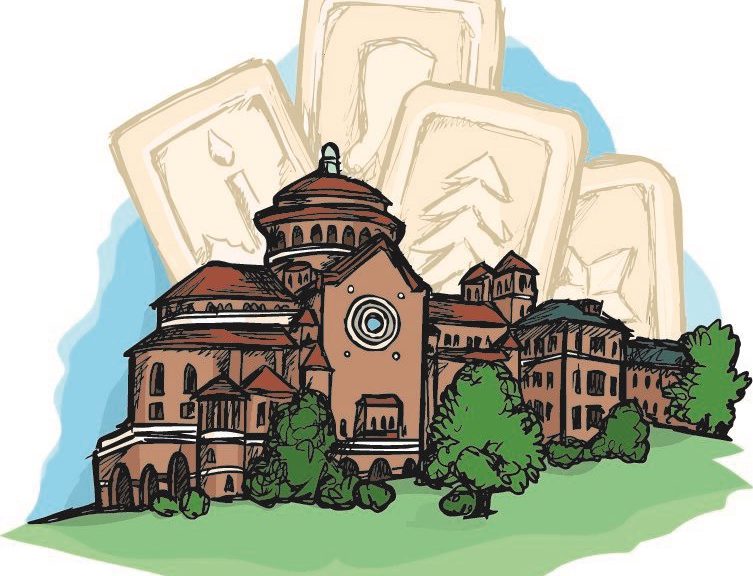Think of springerles as the medieval greeting card of cookies for the 14th century’s 1%. Many of the foods we sell started out as peasant foods, the cuisine of the 99% in a way. Springerles are not one of them. Springerles (pronounced shpring-er-lees) are cookies originally from the Swabia region in southern Germany, where they’re a traditional Christmas treat. They’re beautifully decorated by imprinting a picture on top of the cookie with an intricately carved mold. These cookies were eaten primarily by the wealthy, and even they saved them for the biggest holidays, like Christmas and Easter.
The ingredients were expensive.
The cookies start with white flour, a rarity in the days when milling was done with stones and most bread was made with coarse wholemeal flour. They’re sweetened with white sugar, which would have been brought to Swabia by caravan from the middle east or by boat from the Mediterranean. A rich helping of butter makes the cookies tender. A heady dose of anise gives them a potent, licorice-y flavor. Traditional springerle recipes also include an antiquated leavener called hartshorn, a predecessor of modern baking powder made by grinding up the antlers of male red deer—a close European relative of our American elk—into a powder. (If you want to find hartshorn—more commonly known today as baker’s ammonia—to make your own historic springerles, your best bet is to skip the grocery and look for it at the pharmacy instead.)
Springerles also have one more key component: fancy carved molds. When you press the mold into the cookie dough, it leaves a picture imprinted on top of the cookie. And of course, the fancier and more intricate the mold, the more expensive it was to make.
Cookie molds have been made in the mountains around Swabia since at least the 14th century. Hundreds of years ago, being able to make and share molded cookies meant you were wealthy enough to hire an artisan to carve a mold for you from wood, ceramic, stone, or metal. The molds often had elaborate designs, from whole Christmastime scenes to royal self-portraits. Story has it that the Swabian rich exchanged intricately molded springerle cookies the way we exchange Christmas cards today. You might also commission a special mold to announce a big event, like a wedding or a birth. Those molds became treasured heirlooms, often passed down through the generations in dowries.
Springerles also require the ultimate ingredient: loads and loads of time.
First, there’s the stirring. Making the dough stiff enough for a springerle requires stirring for an hour plus. One recipe I came across involved the whole family. It calls for the baker’s oldest son to stir until he is tired. Then the second oldest son takes over and stirs until he is tired, and so on through the whole family. Today, since child labor laws protect bakers’ kids from that fate, it’s a good thing we’ve got standing mixers!
Once the dough is good and firm and everyone’s forearms are aching (or the KitchenAid has given up the ghost), it’s time to imprint the cookies with your mold. If your family doesn’t have an heirloom passed down through the generations, these days you can find luxe handmade modern molds on Etsy.
After imprinting the cookies and cutting them out, the dough needs to rest for up to a day before baking. This dries the cookies out a bit, creating a thin crust on top of the dough. That way, when you bake the cookies, the image won’t distort.
Even baking takes a fairly long time. Springerles bake at a very low temperature, between 225-300 degrees Fahrenheit, for up to half an hour. During this time, while the image holds it shape, the cookie puffs up tall thanks to the hartshorn (or, more commonly these days, baking powder). This puff is probably where springerles get their name. In German, aufspringen means to “jump up”—or spring up.
Our springerles come from the sisters of St. Benedict Monastery in Ferdinand, Indiana.
It’s a long way from Swabia, but the recipe likely has Swabian roots: it came from a sister with Germanic heritage who joined the monastery in the 1800s. They’ve been baking springerles with that recipe ever since. They imprint each cookie with a mold carved with one of six simple, seasonal patterns, like a pine tree, a star, or a holly branch.
Today, springerles—like many holiday sweets with their roots in the middle ages, like stollen, panettone, and panforte—are no longer reserved for the 1%. White flour, sugar, baking powder, and spices like anise are now commonplace. And starting nearly 200 years ago, mass production made cookie molds accessible to Swabian—and today, global—home bakers. But for the holiday season, they still make for a special treat.
People who love springerles really, really love them.
My grandpa, Frank, fondly remembers springerles from his childhood in the 1930s. His mother, whose family had come to the US from Germany, made springerles each year at Christmas time. She tried to keep them hidden, but it didn’t work very well. “We had a cellar under the back porch where we kept foods cool,” he recalls, “and my mother kept the cookie tin down there. I would go down to sneak a springerle whenever I could!”
Springerles have a hearty texture, with a bit of crunch on the outside and a smooth, soft interior. The flavor is a deep with the characteristic licorice-y note of anise. That anise flavor can be polarizing, and not everyone shares my grandpa’s enthusiasm. But for people who love them, they’re a real treat. They’re ideal nibbled alongside tea or milk, or a glass of dessert wine. Or, best of all, nicked from the cookie tin while Mom’s not watching.

